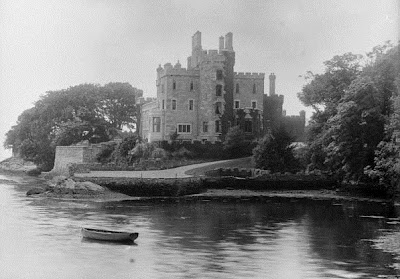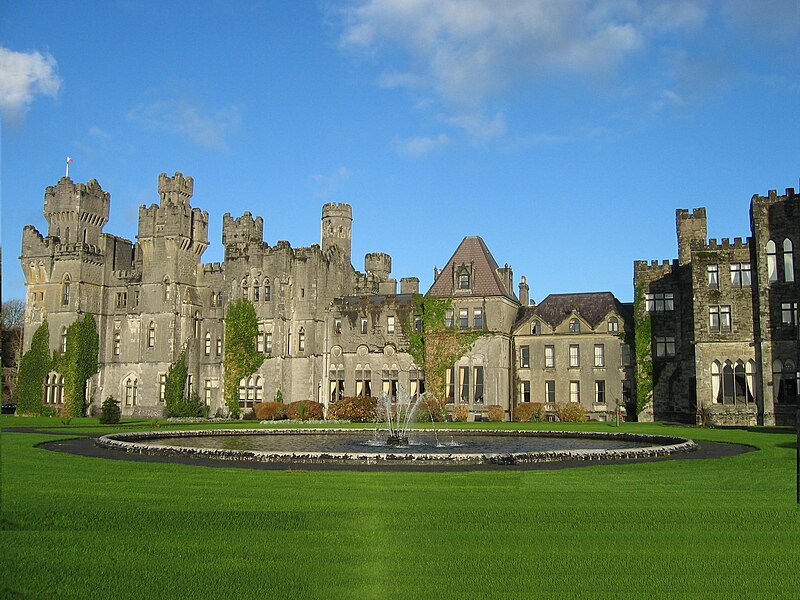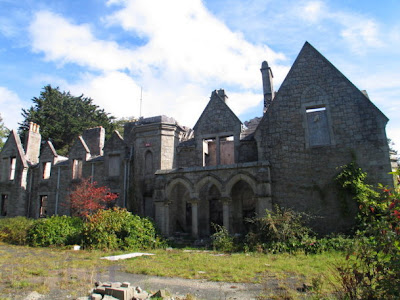The family of LAWLESS was of English extraction, but were settled for many years in Ireland, and became first enriched by commerce, and then ennobled on account of their wealth. SIR HUGH DE LAWLESS, of Hoddesdon, Hertfordshire, settled in Ireland during the reign of HENRY II and obtained a grant from the crown of the manor of Shanganagh, County Dublin, where he erected a castle, the ruins of which are still visible.
RICHARD LAWLESS was Provost of Dublin, 1311, and held the office of Chief Magistrate for three successive years. STEPHEN LAWLESS was consecrated Bishop of Limerick in 1354, and died on Innocents' Day, 1359.
WALTER LAWLESS, of Talbot's Inch, County Kilkenny, had a grant from JAMES I, in 1608, of seven manors, situated in counties Tipperary, Waterford, and Kilkenny, with rights of patronage, to be held for ever, in capite, by knight's service.
He married Margaret, daughter of Robert Wrothe, and died in 1627, leaving an only son,
RICHARD LAWLESS, who succeeding at Talbot's Inch, wedded Margaret, daughter of Patrick Den, of Grennan, County Kilkenny; and dying in 1670, left issue, two sons,
THOMAS LAWLESS, of Talbot's Inch, espoused Elizabeth, daughter of James Butler, of Kilkenny; and dying in 1704, was father of
JOHN LAWLESS, of Shankill, County Dublin, who married Frances, daughter of John Usher, of Crumlin, and had issue, Peter, ancestor of the family seated at Shankill, and
JOHN LAWLESS, who wedded Elizabeth, daughter of Richard MacDonnell.
He died in 1730, and was succeeded by his only son,
ROBERT LAWLESS, of Abington, County Limerick, by Mary, daughter of Dominick Hadsor, of Dublin. and had issue,
He married Margaret, daughter of Robert Wrothe, and died in 1627, leaving an only son,
RICHARD LAWLESS, who succeeding at Talbot's Inch, wedded Margaret, daughter of Patrick Den, of Grennan, County Kilkenny; and dying in 1670, left issue, two sons,
Walter, an adherent of JAMES II;The younger son,
THOMAS, of whom hereafter.
THOMAS LAWLESS, of Talbot's Inch, espoused Elizabeth, daughter of James Butler, of Kilkenny; and dying in 1704, was father of
JOHN LAWLESS, of Shankill, County Dublin, who married Frances, daughter of John Usher, of Crumlin, and had issue, Peter, ancestor of the family seated at Shankill, and
JOHN LAWLESS, who wedded Elizabeth, daughter of Richard MacDonnell.
He died in 1730, and was succeeded by his only son,
ROBERT LAWLESS, of Abington, County Limerick, by Mary, daughter of Dominick Hadsor, of Dublin. and had issue,
NICHOLAS, his heir;Mr Lawless died in 1779, and was succeeded by his only son and heir,
Mary (1736-67).
NICHOLAS LAWLESS (1735-99), of Abington, County Limerick, who, having returned to Ireland from Normandy subsequently to his father's decease and conformed to the established church, obtained a seat in parliament as MP for Lifford, 1776-89.
Mr Lawless was created a baronet in 1776, designated of Abington, County Limerick; and elevated to the peerage, in 1789, in the dignity of BARON CLONCURRY, of Cloncurry, County Kildare.
He married, in 1761, Margaret, only daughter of Valentine Browne, of Dublin, and had issue,
VALENTINE BROWNE, 2nd Baron (1773-1853), who wedded firstly, in 1803, Elizabeth Georgiana, daughter of Lieutenant-General Charles Morgan, and had issue,
Mr Lawless was created a baronet in 1776, designated of Abington, County Limerick; and elevated to the peerage, in 1789, in the dignity of BARON CLONCURRY, of Cloncurry, County Kildare.
He married, in 1761, Margaret, only daughter of Valentine Browne, of Dublin, and had issue,
VALENTINE BROWNE, his successor;His lordship was succeeded by his eldest son,
Mary Catherine; Valentina Alicia; Charlotte Louisa.
VALENTINE BROWNE, 2nd Baron (1773-1853), who wedded firstly, in 1803, Elizabeth Georgiana, daughter of Lieutenant-General Charles Morgan, and had issue,
Mary Margaret; Margaret; Valentine Anne.
He espoused secondly, in 1811, Emily, daughter of Archibald Douglas, and had further issue,
Cecil John (died 1853);EDWARD, of whom hereafter.
The younger son,
EDWARD, 3rd Baron (1816-69), of Lyons, County Kildare, High Sheriff of County Kildare, 1838, County Dublin, 1846, married, in 1839, Elizabeth, daughter of Major John Kirwan, and had issue,
Edward, Colonel, died 1921;VALENTINE, his successor;FREDERICK, 5th Baron;
His lordship took his own life by throwing himself from the third floor of Lyons.
He was succeeded by his eldest son,
VALENTINE, 4th Baron (1840-1928), of Lyons, High Sheriff of County Kildare, 1867, who wedded, in 1883, Laura Sophia Priscilla, daughter of Rowland, 1st Baron St Oswald, and had issue, two daughters,
Mary; Kathleen Emily Marie (1888-1957), of Lyons.
His lordship died without male issue, when the title devolved upon his brother,
FREDERICK, 5th Baron (1847-1929), who served on the staff of two Lords Lieutenant of Ireland, was unmarried; and the titles expired on his death in
1929.
LYONS, near Hazlehatch, County Kildare, was originally the seat of the Aylmer family, though they sold it to the 1st Baron Cloncurry, who had a new house built in 1797.
The present mansion house is a three storey block with a curved bow on either side of its entrance front, joined to two-storey wings by curved sweeps.
About 1801, shortly after his release from the Tower of London, the 2nd Baron hired Richard Morrison to undertake improvements and alterations to his father's house, work continuing till 1805.
During this period, Lord Cloncurry was in Italy, collecting antiques and objets d'art for the house.
The seven-bay garden front was left fairly plain, though an immense formal garden was laid out, with abundant statuary and urns.
Beyond the lake, reputedly the largest artificial lake in Ireland, lies the Hill of Lyons.
The Grand Canal passes along one side of the demesne, with a very fine range of Georgian buildings, comprising the Cloncurry private canal station.
The Hon Kathleen Lawless bequeathed the Lyons estate to a cousin, Mr G M V Winn, who sold it about 1962 to University College, Dublin.
Sir Michael Smurfit KBE owned Lyons from 1990-96.
Lyons was later purchased by Dr Tony Ryan, who reputedly spent €100 million on its restoration.
The house stands in nearly 600 acres, including some fine formal gardens.
The orangery and hall contain a large swimming-pool.
There are seven suites in the main house, a self-contained guest wing with four bedrooms, and staff quarters in the north wing.
A further five lodges are located around the estate which include a 22-acre spring-fed lake which is stocked with trout and, for equestrian enthusiasts, there are stables, stud farm facilities and outstanding natural gallops.
Dublin is a 45-minute drive, but private jet access is available on request at nearby Baldonnel's Casement Aerodrome which is three miles from the estate.
It has undergone a total refurbishment which was recognized as outstanding when it received the Europa Nostra and Institut International des Châteaux Historiques joint award for refurbishment.
Cloncurry arms courtesy of European Heraldry. First published in June, 2012.
LYONS, near Hazlehatch, County Kildare, was originally the seat of the Aylmer family, though they sold it to the 1st Baron Cloncurry, who had a new house built in 1797.
The present mansion house is a three storey block with a curved bow on either side of its entrance front, joined to two-storey wings by curved sweeps.
About 1801, shortly after his release from the Tower of London, the 2nd Baron hired Richard Morrison to undertake improvements and alterations to his father's house, work continuing till 1805.
During this period, Lord Cloncurry was in Italy, collecting antiques and objets d'art for the house.
The seven-bay garden front was left fairly plain, though an immense formal garden was laid out, with abundant statuary and urns.
Beyond the lake, reputedly the largest artificial lake in Ireland, lies the Hill of Lyons.
The Grand Canal passes along one side of the demesne, with a very fine range of Georgian buildings, comprising the Cloncurry private canal station.
The Hon Kathleen Lawless bequeathed the Lyons estate to a cousin, Mr G M V Winn, who sold it about 1962 to University College, Dublin.
Sir Michael Smurfit KBE owned Lyons from 1990-96.
Lyons was later purchased by Dr Tony Ryan, who reputedly spent €100 million on its restoration.
The house stands in nearly 600 acres, including some fine formal gardens.
The orangery and hall contain a large swimming-pool.
There are seven suites in the main house, a self-contained guest wing with four bedrooms, and staff quarters in the north wing.
A further five lodges are located around the estate which include a 22-acre spring-fed lake which is stocked with trout and, for equestrian enthusiasts, there are stables, stud farm facilities and outstanding natural gallops.
Dublin is a 45-minute drive, but private jet access is available on request at nearby Baldonnel's Casement Aerodrome which is three miles from the estate.
It has undergone a total refurbishment which was recognized as outstanding when it received the Europa Nostra and Institut International des Châteaux Historiques joint award for refurbishment.
Cloncurry arms courtesy of European Heraldry. First published in June, 2012.








































